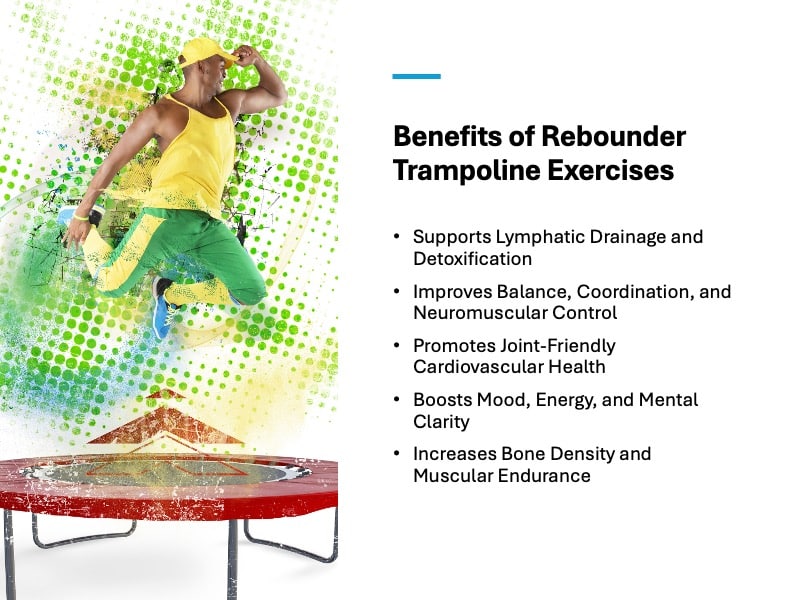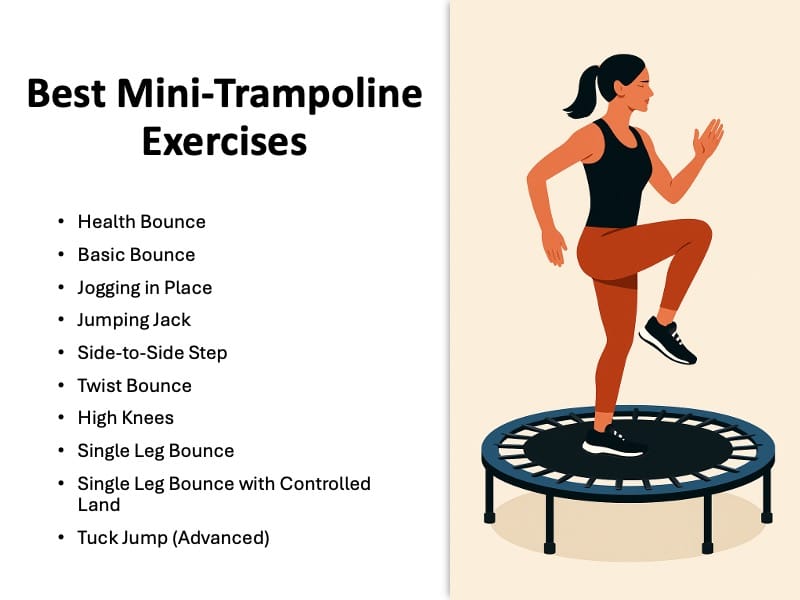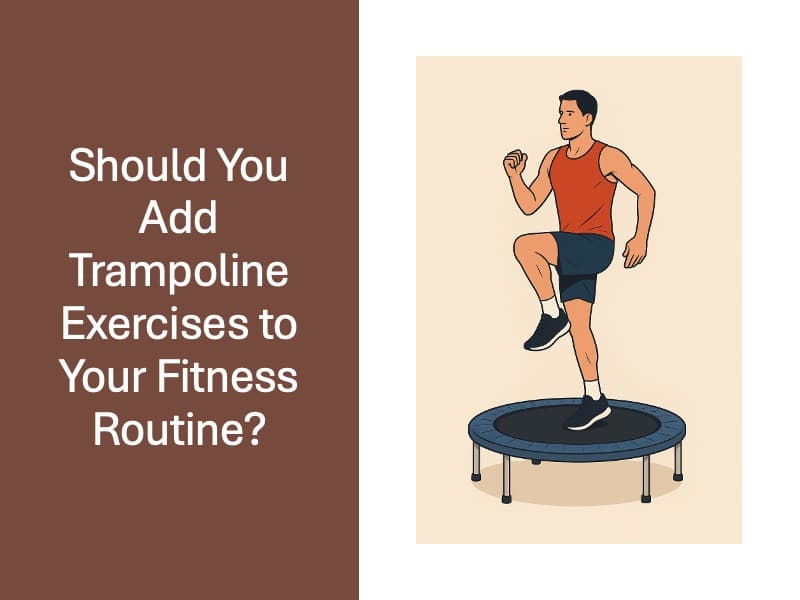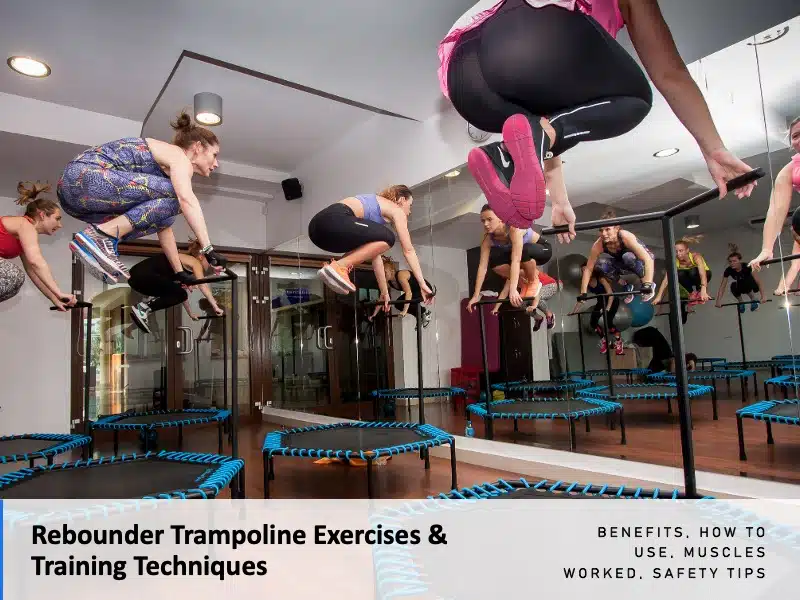Best Rebounder Trampoline Exercises & Training Techniques
Rebounder trampoline exercises are a fun, joint-friendly, and deceptively powerful way to improve your fitness from home.
Whether your goal is to slim down, gain strength, or just enjoy movement again, rebounding workouts offer a low-impact path to total-body transformation.
As a professional basketball player, I’ve used rebounders for years, not just to stay fit, but as a tool for rehab and prehab throughout my career.
During injury recovery or maintenance phases, rebounding allowed me to stay active without stressing my joints.
I’ve also incorporated rebounders into my conditioning workouts, using bigger and more durable models to perform high knees, foot fires, and other explosive movements in Tabata workouts.
For these reasopns, it’s been one of my favorite ways to maintain intensity without wear and tear.
Even my wife regularly uses a rebounder when we go to the gym together.
It’s one of those rare tools that’s accessible, versatile, and beneficial for everyone, from elite athletes to beginners and older adults looking to move more comfortably.
Rebounders are easy to store, quick to set up, and don’t require any complicated instructions to get started.
Best of all, they make movement feel enjoyable again, which is one of the most underrated keys to staying consistent with any fitness program.
What Is a Rebounder Trampoline?
A rebounder trampoline, also known as a mini trampoline, is a small, spring-loaded fitness tool built for safe and controlled exercise. Its compact frame and low-to-the-ground design make it perfect for indoor use and accessible for people of all ages.
Unlike large backyard trampolines, rebounders are made for intentional fitness movements that involve balance, cardio, coordination, and lymphatic stimulation.
They’re often used by physical therapists, athletes, and people recovering from injuries to support rehabilitation and whole-body health.
What Are the Benefits of Rebounder Trampoline Exercises?

Trampoline exercises, also known as rebounding, are a full-body workout disguised as fun.
While the movement may feel playful, the physiological effects are profound.
Jumping on a mini trampoline stimulates circulation, activates the lymphatic system, and improves neuromuscular control, all without excessive joint strain.
Unlike repetitive cardio machines or high-impact routines, rebounding introduces constant variability and demands balance, making it a more dynamic and rewarding way to stay fit.
Whether you’re trying to lose weight, improve coordination, or simply feel better in your body, trampoline training delivers a broad spectrum of health benefits.
Supports Lymphatic Drainage and Detoxification
One of the most overlooked benefits of rebounding is its powerful effect on the lymphatic system.
Rebounding exercises have been found to effectively stimulate the lymphatic system, aiding in detoxification and immune function support (Mehta, 2017).
The up-and-down motion of bouncing opens and closes one-way lymphatic valves, serving as a type of detoxification that helps flush out toxins and cellular waste more efficiently.
This process aids in immune support, reduces swelling or puffiness, and promotes better recovery from inflammation or fatigue.
For individuals with sedentary jobs or sluggish circulation, this natural “pump” effect can be transformative.
Improves Balance, Coordination, and Neuromuscular Control
Balancing on a mini trampoline forces your body to make constant micro-adjustments.
These small, rapid muscle contractions engage your core and stabilizing muscles far more than traditional ground-based movements.
As a result, regular rebounding sharpens motor skills and improves proprioception, which is your brain’s awareness of where your body is in space.
This benefit of rebounder exercises is especially valuable for seniors looking to prevent falls or athletes aiming to improve movement precision.
In one study, a 14-week mini-trampoline exercise program improved seniors’ balance and coordination by approximately 35% in some measures, suggesting its effectiveness in reducing fall risk among older adults (Aragao et al., 2011).
Promotes Joint-Friendly Cardiovascular Health
Trampoline exercises are an ideal form of low-impact cardio that spares your knees, ankles, and hips from repetitive pounding.
The mat absorbs most of the shock, allowing you to safely elevate your heart rate and improve aerobic capacity without stressing your joints.
This makes rebounding suitable for people recovering from injuries, those with arthritis, or anyone looking for a safer alternative to running or plyometrics.
Additionally, engaging in mini-trampoline exercises has been shown to improve cardiovascular responses, including increased heart rate and oxygen consumption, indicating improved cardiovascular fitness (Rodrigues et al., 2018).
You get the heart-pumping benefits of trampoline exercises with less wear and tear than running or other forms of exercise!
In fact, a NASA study found that rebounding is significantly more efficient than running.
Specifically, the study concluded that jumping on a trampoline is 68% more effective than jogging in terms of oxygen uptake and cardiovascular benefits (Bhattacharya et al., 1980).
This suggests that trampoline exercises can provide substantial aerobic conditioning with less effort.
Boosts Mood, Energy, and Mental Clarity
The rhythmic movement and gravitational shifts during rebounding stimulate endorphin release, helping to naturally reduce stress and improve mental well-being.
Regular physical activity, including trampoline exercises, has been associated with reduced symptoms of depression and anxiety, improving overall mental well-being (Mikkelsen et al., 2017).
It’s a natural mood booster that combines movement with fun, making it more likely you’ll stick with it.
Many people also report feeling more energized and mentally clear after trampoline sessions, thanks to improved circulation, oxygen delivery, and the meditative, almost hypnotic rhythm of the bounce.
Increases Bone Density and Muscular Endurance
Every bounce sends a mild but consistent load through your bones and muscles, stimulating growth and maintenance.
Over time, this builds bone density, which is a key factor in preventing osteoporosis, especially in aging populations.
In tandem, trampoline workouts develop muscular endurance in the legs, core, and stabilizers.
The consistent activation of these muscles leads to better posture, longer-lasting strength, and improved movement efficiency in daily life.
Calorie Burning & Weight Management
Trampoline exercises are one of the most effective and enjoyable low-impact cardio workouts for weight loss.
Mini-trampoline rebounding has been shown to significantly improve body composition in overweight women, including reductions in fat mass and increases in lean muscle tissue after just 12 weeks of regular training (Cugusi et al., 2018).
These improvements are paired with increased aerobic capacity, blood pressure regulation, and better glucose and lipid profiles, all of which support sustainable weight loss and metabolic health.
Another study found that postmenopausal women who participated in mini-trampoline workouts three times per week experienced gains in aerobic fitness, strength, and functional movement patterns, which are essential components of long-term weight management (Fricke et al., 2021).
Compared to traditional types of cardio workouts, like jogging or cycling, rebounding offers similar fat-burning potential with much lower impact on the joints.
This makes it especially effective for people who are overweight, managing joint pain, or seeking a fun, scalable workout.
Combined with interval formats like Tabata workouts, trampoline training becomes a powerful tool for both fat loss and overall conditioning.
Best Mini Trampoline Exercises to Try

Mini trampoline workouts are a low-impact, high-reward way to improve your strength, cardio, and coordination without stressing your joints.
I’ve used rebounder trampoline exercises for years in my professional basketball training, for both injury recovery and high-level conditioning.
Whether you’re a beginner, athlete, or senior, these moves offer practical, scalable fitness benefits for nearly everyone.
Health Bounce
The health bounce trampoline exercise is a gentle, rhythmic movement that activates circulation and supports your lymphatic system. It’s one of the most accessible ways to get started on a rebounder.
- Benefits: Stimulates lymphatic drainage, improves circulation, supports recovery
- Muscles Worked: Calves, deep core stabilizers, ankles
- How to Do: Stand tall with soft knees and bounce gently, keeping your feet in contact with the trampoline at all times. Focus on small, controlled movements and steady breathing.
- Safety Tips: Stay centered, avoid locking your joints, and use this move as a warm-up or cool-down to ease your body in and out of higher-intensity work.
Basic Bounce
The basic bounce rebounder trampoline exercise is a foundational move that builds timing, endurance, and balance, and it is perfect for beginners and those returning from injury.
- Benefits: Improves cardiovascular stamina, joint stability, and bounce rhythm
- Muscles Worked: Quadriceps, hamstrings, calves, lower core
- How to Do: Gently jump 1–2 inches off the trampoline surface. Use your arms for natural balance and keep your landings soft with bent knees.
- Safety Tips: Don’t jump too high. Focus on control, and brace your core to avoid excessive wobbling.
Jogging in Place
The jogging in place exercise on a rebounder is one of the best ways to simulate running without the joint impact.
I’ve used this countless times to maintain conditioning while recovering from ankle issues.
- Benefits: Builds endurance, improves balance, and promotes cardio conditioning
- Muscles Worked: Glutes, hip flexors, calves, hamstrings, core
- How to Do: Mimic a running motion by lifting one foot at a time while bouncing. Move your arms in sync for momentum and rhythm.
- Safety Tips: Keep your feet underneath your hips and stay upright. Begin slowly and increase speed as your balance improves.
Jumping Jack
The jumping jack trampoline exercise adds a layer of instability that increases muscle recruitment, particularly in the core and stabilizers, while still delivering a strong cardio effect.
- Benefits: Full-body coordination, calorie burn, improved agility
- Muscles Worked: Deltoids, inner thighs, calves, glutes, abdominals
- How to Do: Jump your feet apart while lifting your arms overhead, then return to the starting position. Maintain a consistent pace and controlled motion.
- Safety Tips: Land with knees soft, avoid overextending limbs, and keep your movements fluid to stay balanced.
Side-to-Side Step
The side-to-side step rebounder exercise is ideal for training lateral strength and hip mobility, which is something I emphasize heavily in prehab routines for athletic performance and injury prevention.
- Benefits: Strengthens glutes and hips, boosts coordination, improves lateral mobility
- Muscles Worked: Glute medius, abductors, quads, calves, obliques
- How to Do: Step to the right side of the trampoline with your right foot, then bring your left foot to meet it. Repeat in the opposite direction, building a rhythmic flow.
- Safety Tips: Stay light on your feet and avoid crossing your legs. Keep your hips level and posture tall throughout the movement.
Twist Bounce
The twist bounce exercise on a mini trampoline builds rotational strength and balance while improving coordination. It’s a fun way to add core engagement to a cardio-focused routine.
- Benefits: Improves spinal mobility, targets obliques, builds balance
- Muscles Worked: Obliques, transverse abdominis, hip rotators, stabilizers
- How to Do: As you bounce lightly, twist your lower body to the right while your upper body turns left, then switch sides. Keep the motion tight and controlled.
- Safety Tips: Keep your spine upright and avoid jerking into the twist. Start slow and build up your rotation as your control improves.
High Knees
The high knees rebounder trampoline exercise is one of the most powerful fat-burning movements you can do on a mini trampoline.
- Benefits: Elevates heart rate, strengthens the core, develops athletic conditioning
- Muscles Worked: Hip flexors, quads, abs, calves, shoulders
- How to Do: Run in place while lifting your knees toward your chest with each step. Keep a fast tempo and swing your arms in rhythm.
- Safety Tips: Keep your weight centered and core braced. Land lightly and only lift knees as high as your stability allows.
Single Leg Bounce
The single leg bounce trampoline exercise is a balance-focused movement that strengthens stabilizing muscles and improves neuromuscular coordination. It’s a great progression from basic bounce work and an excellent prehab tool for ankle and knee health.
- Benefits: Improves balance, strengthens ankle stabilizers, enhances single-leg control
- Muscles Worked: Glutes, calves, hamstrings, quadriceps, core stabilizers
- How to Do: Stand tall on one leg in the center of the rebounder with the opposite foot lifted slightly off the surface. Begin bouncing gently by bending and extending the knee of your standing leg. Keep your arms out for balance and your core tight to stay centered.
- Safety Tips: Start close to a wall or support bar if needed. Keep the bounce small and controlled—don’t try to jump high. Switch legs every 20–30 seconds or after a set number of bounces.
Single Leg Bounce with Controlled Land
The single leg bounce and controlled land trampoline exercise is a more advanced version that trains eccentric control and landing mechanics. It’s especially valuable for athletes, or anyone working on reducing injury risk in the knees and ankles.
- Benefits: Builds landing strength, teaches force absorption, enhances joint resilience
- Muscles Worked: Quads, glutes, hamstrings, calves, deep core stabilizers
- How to Do: Start in a balanced standing position on both feet. Lightly jump and land on one leg, absorbing the impact with a soft knee and engaged core. Hold the landing briefly before returning to the starting position or switching legs.
- Safety Tips: Focus on quiet, controlled landings. Avoid letting the knee collapse inward and keep your weight evenly distributed over the midfoot. Perform slowly and deliberately to prioritize form over speed.
Tuck Jump (Advanced)
The tuck jump trampoline exercise is an explosive plyometric move that develops power and agility. This is best reserved for athletes or advanced exercisers with good control and body awareness.
- Benefits: Builds explosive strength, improves anaerobic conditioning, enhances agility
- Muscles Worked: Glutes, quadriceps, hamstrings, hip flexors, core
- How to Do: Jump straight up and bring your knees toward your chest mid-air. Reset and repeat once you land in a controlled position.
- Safety Tips: Perform only when fully warmed up. Start with low reps (10–15 seconds) and land softly with knees bent to reduce joint impact.
Rebounder Trampoline Exercises for Specific Groups
Rebounders can be adapted to fit almost anyone’s routine—whether you’re recovering from an injury or training to get lean.
Here’s how to modify mini trampoline workouts based on your fitness level and goals:
For Seniors
Trampoline exercises for seniors promote balance, coordination, and circulation, all without high-impact stress.
Rebounding also gently stimulates the lymph system and improves confidence with movement.
Trampoline workouts can also serve as an accessible form of physical therapy for seniors, helping improve mobility, joint stability, and overall functional independence in a fun, low-stress environment.
Best options include:
- Health bounce
- Marching in place
- Gentle side steps
These low-impact exercises improve daily functionality while reducing the fear of falling or getting hurt.
For Beginners
If you’re just starting out, mini trampoline exercises for beginners are perfect because they’re fun, unintimidating, and build body awareness quickly.
The springy surface provides cushion and feedback, which makes learning basic movement patterns more comfortable.
Start with:
- Basic bounce
- Side-to-side step
- Light jog in place
These build a solid base while boosting your heart rate and improving coordination.
For Weight Loss
Rebounding burns calories fast thanks to its full-body activation and ability to elevate your heart rate with minimal joint strain.
It’s a great option for people who want a fun and efficient way to shed pounds without the harshness of running or burpees.
Top picks:
- High knees
- Tuck jumps
- Jumping jacks
These movements torch fat and keep your body guessing with every bounce.
Final Thoughts: Should You Add Trampoline Exercises to Your Fitness Routine?

If you’re looking for a smart, low-impact way to improve your cardio, strength, balance, and mobility, all while having fun, then trampoline exercises absolutely deserve a spot in your fitness routine.
Rebounding offers a rare combination of joint-friendly movement, full-body activation, and functional benefits that few other tools can match.
Whether you’re rehabbing an injury, building endurance with high knees and Tabata intervals like I’ve done in-season, or just trying to get moving again with something enjoyable and sustainable, a rebounder can meet you where you are.
It’s accessible for beginners and challenging enough for athletes.
Even my wife and I use rebounders regularly at the gym because they’re efficient, effective, and easy to integrate into any program.
From lymphatic support and improved coordination to calorie-burning and core strength, mini trampoline workouts offer real performance and health benefits, not gimmicks.
If staying consistent with exercise has ever been a struggle for you, a rebounder might just be the tool that helps you move better, feel better, and actually look forward to your workouts.
Frequently Asked Questions About Rebounder Trampoline Exercises
This website does not provide medical advice. This website site does contain affiliate links, and purchases may earn a commission.
Read my Medical Disclaimer, Review Disclaimer, and Publishing Policies for more details. Use of this site indicates acceptance of these terms.



